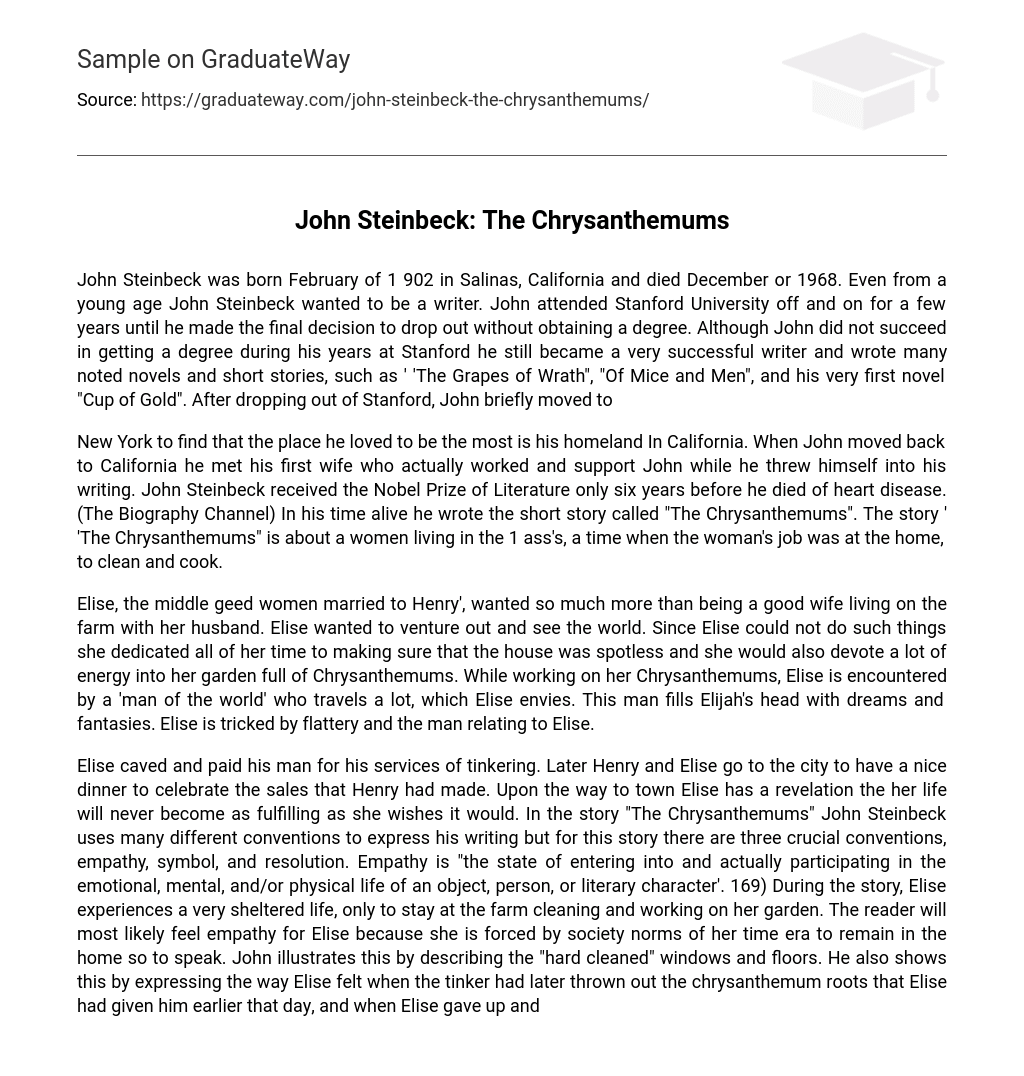John Steinbeck was born February of 1 902 in Salinas, California and died December or 1968. Even from a young age John Steinbeck wanted to be a writer. John attended Stanford University off and on for a few years until he made the final decision to drop out without obtaining a degree. Although John did not succeed in getting a degree during his years at Stanford he still became a very successful writer and wrote many noted novels and short stories, such as ‘ ‘The Grapes of Wrath”, “Of Mice and Men”, and his very first novel “Cup of Gold”. After dropping out of Stanford, John briefly moved to
New York to find that the place he loved to be the most is his homeland In California. When John moved back to California he met his first wife who actually worked and support John while he threw himself into his writing. John Steinbeck received the Nobel Prize of Literature only six years before he died of heart disease. (The Biography Channel) In his time alive he wrote the short story called “The Chrysanthemums”. The story ‘ ‘The Chrysanthemums” is about a women living in the 1 ass’s, a time when the woman’s job was at the home, to clean and cook.
Elise, the middle geed women married to Henry’, wanted so much more than being a good wife living on the farm with her husband. Elise wanted to venture out and see the world. Since Elise could not do such things she dedicated all of her time to making sure that the house was spotless and she would also devote a lot of energy into her garden full of Chrysanthemums. While working on her Chrysanthemums, Elise is encountered by a ‘man of the world’ who travels a lot, which Elise envies. This man fills Elijah’s head with dreams and fantasies. Elise is tricked by flattery and the man relating to Elise.
Elise caved and paid his man for his services of tinkering. Later Henry and Elise go to the city to have a nice dinner to celebrate the sales that Henry had made. Upon the way to town Elise has a revelation the her life will never become as fulfilling as she wishes it would. In the story “The Chrysanthemums” John Steinbeck uses many different conventions to express his writing but for this story there are three crucial conventions, empathy, symbol, and resolution. Empathy is “the state of entering into and actually participating in the emotional, mental, and/or physical life of an object, person, or literary character’. 169) During the story, Elise experiences a very sheltered life, only to stay at the farm cleaning and working on her garden. The reader will most likely feel empathy for Elise because she is forced by society norms of her time era to remain in the home so to speak. John illustrates this by describing the “hard cleaned” windows and floors. He also shows this by expressing the way Elise felt when the tinker had later thrown out the chrysanthemum roots that Elise had given him earlier that day, and when Elise gave up and said that she would settle for the wine rather than going to the fights.
Although these connections would not be easily understood with out realizing the symbol behind the specific events and objects. “A symbol in literature is any word, image, object, action, or character that embodies and evokes a range of additional meaning and significance”. (11 72) There are many symbols in the story “The Chrysanthemums”, starting with the fenced yard which symbolizes Elijah’s sheltered life, never to leave the set boundaries. The tinker represents that life Elise wishes to live. The chrysanthemum roots represented her being able to leave the home and spread her roots in far laces.
The garden of chrysanthemums itself represented some what of Elijah’s “babies” because she and Henry do not have children for unexplained reasons. The city represents a mysterious, adventurous, life something new. The bottle of wine offered up to Elise from Henry on the way to the city is representative of a life not full of experiences and adventure but still a little more than what her life is consisted of. The boxing fights represent similar to the tinker, dangerous and adventurous and heart racing. Which brings the Story to the resolution.
Resolution is “the final section Of the plot in which the major conflict, issue, or problem is resolved”. (1 171 ) The final resolution of the story was when Henry and Elise were in the car on their way to the city and Elise saw the chrysanthemum roots in the road and realized that her life, like the chrysanthemum roots will never be more than what it already is, she will never explore or experience life as fulfilling as she wishes it could be. John shows Elise giving up in the end after she comes to this conclusion, by crying and agreeing to just settle with the wine rather than admitting she wanted to go to the fights.
Although the resolution is not as happy and fulfilling as audiences hope and expect to be. John portrays the struggle of women’s rights in the era of the 1 ass’s, where the woman’s job what in the home. Over all, the story “The Chrysanthemums” about a mid aged woman who struggles to except what her life will consist of, uses literary conventions that adds volume, and texture to the story. It allows the story to feel rich in symbol that represents very small, but important parts of Elise, her daily life, and her future life.





